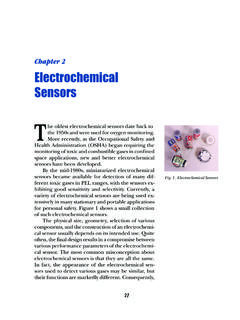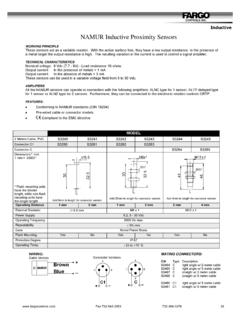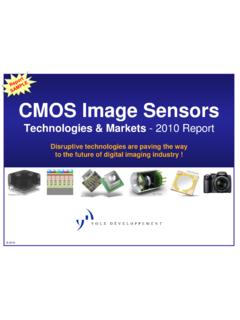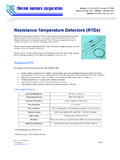Transcription of Sensors, Chemical Sensors, Electrochemical …
1 Journal of The Electrochemical Society, 150 2 S11-S16 2003 S11. 0013-4651/2003/150 2 /S11/6/$ The Electrochemical Society, Inc. Sensors, Chemical Sensors, Electrochemical Sensors, and ECS. Joseph R. Stetter,*,z William R. Penrose,* and Sheng Yao*. BCPS Department, Illinois Institute of Technology, Chicago, Illinois 60616, USA. The growing branch of science and technology known as sensors has permeated virtually all professional science and engineering organizations. sensor science generates thousands of new publications each year, in publications ranging from magazines such as Popular Mechanics and Discover to learned journals like the Journal of The Electrochemical Society (JES). The Electrochemical Society ECS , which has declared itself the society for solid state and Electrochemical science and technology, and its worldwide membership, have been vitally instrumental in contributions to both the science and technology underlying sensors. This article is about a few of the Chemical sensors that have evolved, those still now evolving, and the continuing role of ECS in advancement of sensor science and engineering.
2 2003 The Electrochemical Society. DOI: All rights reserved. Available electronically January 13, 2003. Chemical sensors have been widely used in such applications as materials, and nano-materials nano-particles, nano-wires, nano- critical care, safety, industrial hygiene, process controls, product tubes are all examples. quality controls, human comfort controls, emissions monitoring, au- The Society has proven to be an ideal organization for sensor tomotive, clinical diagnostics, home safety alarms, and, more re- research because of its long tradition of providing a home for sci- cently, homeland security. In these applications, Chemical sensors ence and technology at the interface of many disciplines. Through have resulted in both economic and social benefits. Some examples the pages of its respected journals, JES and Electrochemical and of market areas are summarized in Table I. Indoor air quality IAQ , Solid-State Letters ESL , ECS has chronicled developments for volatile organic compounds VOCs , and the lower explosive limit many types of sensors including amperometric sensors, potentiomet- of combustible hydrocarbons HCs have all become targets for new ric sensors, and chemiresistors.
3 JES has published more than 200. sensor developments that seek to monitor and help improve the papers on Chemical sensors since 1990 Vol. 137-149 , and ESL has quality of the air we breathe. The range of detection for sensors can reached 26 Chemical sensor papers since its inception in 1998. Of be percent levels in process streams with O2 sensors to single mol- the 26 sensor -related papers in ESL, more than 60% discuss solid ecule or unique organism detection with carbon nanotubes. electrolyte sensors. The interest in this type of sensor is growing and is the topic of a joint meeting of the ECS sensor Division and the ECS sensor Related Symposia and Publications American Ceramic Society ACerS to be held in the Fall of 2003 in Orlando. The Electrochemical Society formally recognized its role in More and more ECS members are interested in microfluidics, Chemical sensor technology and the importance of sensors with the microsystems, and nanodevices, many of which are considered formation of the sensor Group in 1987.
4 This grew into the sensor physical sensors as well as being part of Chemical and biochemical Division founded in 1993 by Dennis Turner and co-organizers. The devices. The physical sensors which detect physical properties of new Group organized a successful Chemical Sensors symposium for mass, force, pressure, strain, temperature, flow, position, distance, the 1987 ECS Fall meeting in Honolulu, a joint international meet- and acceleration have been directly enabled by advances in elec- ing with the Electrochemical Society of Japan ECSJ . Subse- tronic fabrication processes. Hybrid physical- Chemical systems open quently, the symposium was continued as a series in the 1993 and new areas for sensor design and bring the promise of advanced 1999 Fall meetings in Honolulu. Norboru Yamazoe, a founder of the analytical systems capability on a single chip. International Meeting on Chemical Sensors IMCS , was co- chairman and contributed significantly to obtaining many papers from Japan and the East for these symposia.
5 Sensors, Chemical Sensors, and Electrochemical Sensors sensor research takes place in virtually every ECS division see The world seems to have a natural division between Chemical Table II , and these listed 80 or so symposia represent about 7% of and physical sensors. However, there are those that do not classify all ECS symposia. A series of state of the art conferences have been easily, like relative humidity sensors, a Chemical sensor traditionally organized by the sensor Division over the past 10 years and lumped with physical sensors. Also, sensors are often discussed progress in this field can be found in ECS publications, including along with the topic of actuators. Chemical sensors have a Chemical proceedings The ECS sensor symposia span diverse or molecular target to be measured. Biosensors are defined as sen- topics, including biosensors, luminescent materials, ion-selective sors that use biomolecules and/or structures to measure something electrodes, and high-temperature ceramic sensors.
6 General broad with biological significance or bioactivity. More appropriately, bio- coverage symposia on Chemical sensors provide opportunity for in- sensors target a biomolecule of interest for measurement. The bio- terdisciplinary discussions on both fundamental and applied aspects sensor can usually be considered a subset of Chemical sensors be- of all kinds of Chemical sensors, while most symposia have dedi- cause the transduction methods, sometimes referred to as the sensor cated topics that focus on solving special problems of significance at platforms, are the same as those for Chemical sensors. Chemical that time. Table III provides a classification of the ECS sensor sym- sensor arrays with instrumentation, having popular names like the posia according to topics, and most topical symposia were launched electronic nose or electronic tongue,5 have been constructed to ad- to discuss special applications like industrial, medical, or environ- dress chemically complex analytes like taste, odor, toxicity, or fresh- mental sensors.
7 This focus supports the strong connection between ness. sensors and practical problems in technology, industry, and society. A useful definition for a Chemical sensor is a small device that The second largest category of symposia concerns materials. sensor as the result of a Chemical interaction or process between the analyte technology is dependent on progress in materials science and tech- gas and the sensor device, transforms Chemical or biochemical in- nology, and whenever a new material is discovered it is soon inves- formation of a quantitative or qualitative type into an analytically tigated for applications to sensors. Conducting polymers, solid ionic useful signal.'' The definition is illustrated in Fig. 1a and compared to two other sensor devices, specifically, the microinstrument Fig. 1b and the lab-on-a-chip'' sensor concept Fig. 1c . The microin- * Electrochemical Society Active Member. strument using the physical sensor for light or heat would have a z E-mail: similar definition to the Chemical sensor except there is no interac- S12 Journal of The Electrochemical Society, 150 2 S11-S16 2003.
8 Table I. Exemplary Applications and Markets for Chemical Sensors. Market/application Examples of detected Chemical compounds and classes Automotive O2 , H2 , CO, NOx , HCs, IAQ CO, CH4 , humidity, CO2 , VOCs, Food Bactreria, biologicals, chemicals, fungal toxins, humidity, pH, CO2 , Agriculture NH3 , amines, humidity, CO2 , pesticides, herbicides, Medical O2 , glucose, urea, CO2 , pH, Na , K , Ca2 , Cl , bio-molecules, H2 S, Infectious disease, ketones, anesthesia gases, Water treatment pH, Cl2 , CO2 , O2 , O3 , H2 S, Environmental SOx , CO2 , NOx , HCs , NH3 , H2 S, pH, heavy metal ions Industrial safety Indoor air quality, toxic gases, combustible gases, O2 , Utilities gas, electric O2 , CO, HCs , NOx , SOx , CO2 , Petrochemical HCx , conventional pollutants, Steel O2 , H2 , CO, conventional pollutants, Military Agents, explosives, propellants, Aerospace H2 , O2 , CO2 , humidity, tion of the analyte gas with the sensor device, but rather the analyte amperometric, and impedance or admittance based devices.
9 Biosen- modulates the energy absorbed or emitted by the physical sensor . sors, while directed toward analysis for a specific or significant bio- The lab-on-a-chip or -TAS micro-Total Analytical System is con- logical material or bio-endpoint3 will utilize one or more of these sidered a sensor in only the broadest of definitions and is really a principles. Optical and acoustic or similar approaches are also in- complete analytical system. cluded in Electrochemical sensors if a broad definition of these terms The signal from a sensor is typically electronic in nature, being a is used. Electrochemical sensors can be applied for solid, liquid, or current, voltage, or impedance/conductance change caused by gaseous analytes with the latter two most common. High tempera- changing analyte composition or quality. While Chemical sensors tures can be accommodated using solid electrolytes and high- contain a physical transducer and a chemically sensitive layer or temperature materials for sensor device construction.
10 In the follow- recognition layer, the microinstrument or spectrometer Fig. 1b ing brief discussion, we outline some common Electrochemical sends out an energy signal, be it thermal, electrical, or optical, and sensors see Table IV , and, by illustration, the continued ECS in- reads the change in this same property caused by the intervening terest in sensors. Chemical and this is akin to molecular spectroscopy in the above example. In -TAS, the system, Fig. 1c, can include sampling sys- Semiconducting oxide sensors. The heated metal oxide sensor tem, separation or fluidic instrumentation system, as well as a de- is probably the most investigated and widely produced Chemical tector. The users of sensors, of course, do not care about this divi- sensor and has always been a very popular topic for ECS symposia. sion, but this paradigm is helpful in explaining the types of systems The working principle of this type of sensor is that the resistance of that exist and understanding how they work, why they have certain the metal oxide semiconductor changes when it is exposed to the properties and analytical performance, and how new developments target gas because the target gas reacts with the metal oxide surface are made.




